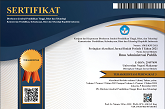Community Empowerment Through Tourism Development in East Kalimantan
(1) Administrasi Publik Fisip-Universitas Mulawarman
(*) Corresponding Author
DOI: https://doi.org/10.26858/jiap.v12i2.38992
Abstract
Keywords
Full Text:
PDFReferences
Arianti, D. (2014). Pengaruh Sektor Pariwisata Terhadap Perekonomian dan Keruangan Kota Bukittinggi (Pendekatan Analisis Input Output). Jurnal Wilayah Dan Lingkungan, 2(3), 183–196.
Chen, S. C., & Elston, J. A. (2013). Entrepreneurial motives and characteristics: An analysis of small restaurant owners. International Journal of Hospitality Management, 35, 294–305.
Crotti, R., & Misrahi, T. (2017). The Travel and Tourism Competitiveness Report. World Economic Forum. Genewa.
Cudai Nur, A., Akib, H., Niswaty, R., Aslinda, A., & Zaenal, H. (2019). Development Partnership Strategy Tourism Destinations Integrated and Infrastructure in South Sulawesi Indonesia. Haedar and Niswaty, Risma and Aslinda, Aslinda and Zaenal, Henny, Development Partnership Strategy Tourism Destinations Integrated and Infrastructure in South Sulawesi Indonesia (August 28, 2019).
Kadji, J. (2015). Optimalisasi Tata Kelola Sektor Pariwisata di Kabupaten Gorontalo. Jurnal Ad’ministrare: Jurnal Pemikiran Ilmiah Dan Pendidikan Administrasi Perkantoran, 2(1), 1–15.
Noor, M. (2011). Pemberdayaan Masyarakat. CIVIS, 1(2).
Nugroho, S. (2020). Beberapa masalah dalam pengembangan sektor pariwisata di Indonesia. Jurnal Pariwisata, 7(2), 124–131.
Peraturan Pemerintah Nomor 50 tahun 2011 tentang Rencana Induk Pembangunan Pariwisata Nasional tahun 2010-2025. , (2011).
Putra, S. H. (2021). Pengembangan UMKM Pariwisata dan New Normal. In Politeknik Ganesha. Medan.
Revida, E., Gaspersz, S., Uktolseja, L. J., Nasrullah, N., Warella, S. Y., Nurmiati, N., … Purba, R. A. (2020). Pengantar Pariwisata. Yayasan Kita Menulis.
Siyoto, S., & Sodik, M. A. (2015). Dasar Metodologi Penelitian. In Dasar Metodologi Penelitian. Yogyakarta: Literasi Media Publishing.
Sugiyono. (2019). Metode Penelitian Kuantitatif Kualitatif Dan R&D. Bandung: Alfabeta.
Undang-undang No. 10 tahun 2009 mengatur bahwa pembangunan kepariwisataan, Pasal 8 Ayat 1. , (2009).
Undang-undang Nomor 10 tahun 2009 tentang Pariwisata mengatur hak masyarakat dalam pembangunan pariwisata Pasal 19. , (2009).
Utami, B. A., & Kafabih, A. (2021). Sektor Pariwisata Indonesia di Tengah Pandemi COVID 19. Jurnal Dinamika Ekonomi Pembangunan, 4(1), 8–14.
Article Metrics
Abstract view : 139 times | PDF view : 28 timesRefbacks
- There are currently no refbacks.
Copyright (c) 2022 2022 Aji Ratna Kusuma

This work is licensed under a Creative Commons Attribution 4.0 International License.
Diterbitkan oleh:
Program Studi Ilmu Administrasi Publik
Program Pascasarjana Universitas Negeri Makassar
JIAP Index By:

This work is licensed under a Creative Commons Attribution 4.0 International License.









